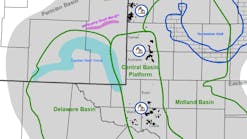Paula Dittrick
OGJ Senior Staff Writer
HOUSTON, Apr. 14 -- BP PLC board members and top executives emphasized safety improvements at an Apr. 14 shareholders meeting in London that drew protesters while fielding many questions about the 2010 Macando oil spill in the Gulf of Mexico.
“Clearly after a very troubled and demanding 12 months, BP is a changed company,” said Carl-Henric Svanberg, BP chairman. “As a board we have much to do…. Foremost is the need to ensure the right checks and balances are in place across the company. The full board will continue to maintain close oversight of matters related to safety.”
The meeting took place 6 days before the Apr. 20 anniversary of the deepwater Macondo well blowout off Louisiana. An explosion and fire on Transocean Ltd.’s Deepwater Horizon semisubmersible killed 11 crew members. A massive oil spill resulted in the gulf.
“In the past 12 months, BP has been through a crisis almost unprecedented in corporate history,” Svanberg said. “We will do all we can to prevent such an accident from happening again.”
BP has strengthened safety through corporate organizational changes, he said, noting former Chief Executive Officer Tony Hayward stepped down after the oil spill and was succeeded by Bob Dudley.
In his Apr. 14 speech to shareholders, Dudley said BP has paid more than $5 billion to individuals, businesses, and government entities for environmental restoration following the spill. During its peak, the response efforts involved more than 48,000 people, 6,500 vessels, and 2,500 miles of boom.
BP created a safety and operational risk organization, and more than 500 specialists are working on that team, he said.
“Furthermore, we have also made changes in our management structure, introducing three divisions in the upstream: exploration, developments, and production, each of which reports directly to me,” Dudley said. “This creates greater clarity and accountability. It also brings specialist staff together in teams where they can share knowledge and build capability.”
The developments division includes a global wells organization responsible for drilling all BP wells, he said. During the last 4 months, BP reviewed the risk management for each of its wells to assess their compliance with standards.
In March, BP employees worldwide were required to state in their performance contracts how they personally will contribute to safety and to teamwork, he said.
BP has signed agreements for more than $24 billion worth of divestitures in its strategy to sell up to $30 billion in assets to ensure corporate financial stability, he said.
“Beyond the impact of the Gulf of Mexico tragedy, which led to a reported loss of $4.9 billion last year, our underlying replacement cost profit—which excludes the costs associated with the Gulf of Mexico oil spill as well as other nonoperating items and fair accounting effects—was $20.5 billion and operating cash flow was $29.6 billion,” Dudley said.
BP reported 2010 reserve replacement of 106% and continues making investments in exploration. BP plans 32 upstream project start ups by yearend 2016.
Dudley said 2011 will be a year of consolidation for BP as it completes its divestment program and implements risk-management changes.
Contact Paula Dittrick at [email protected].
